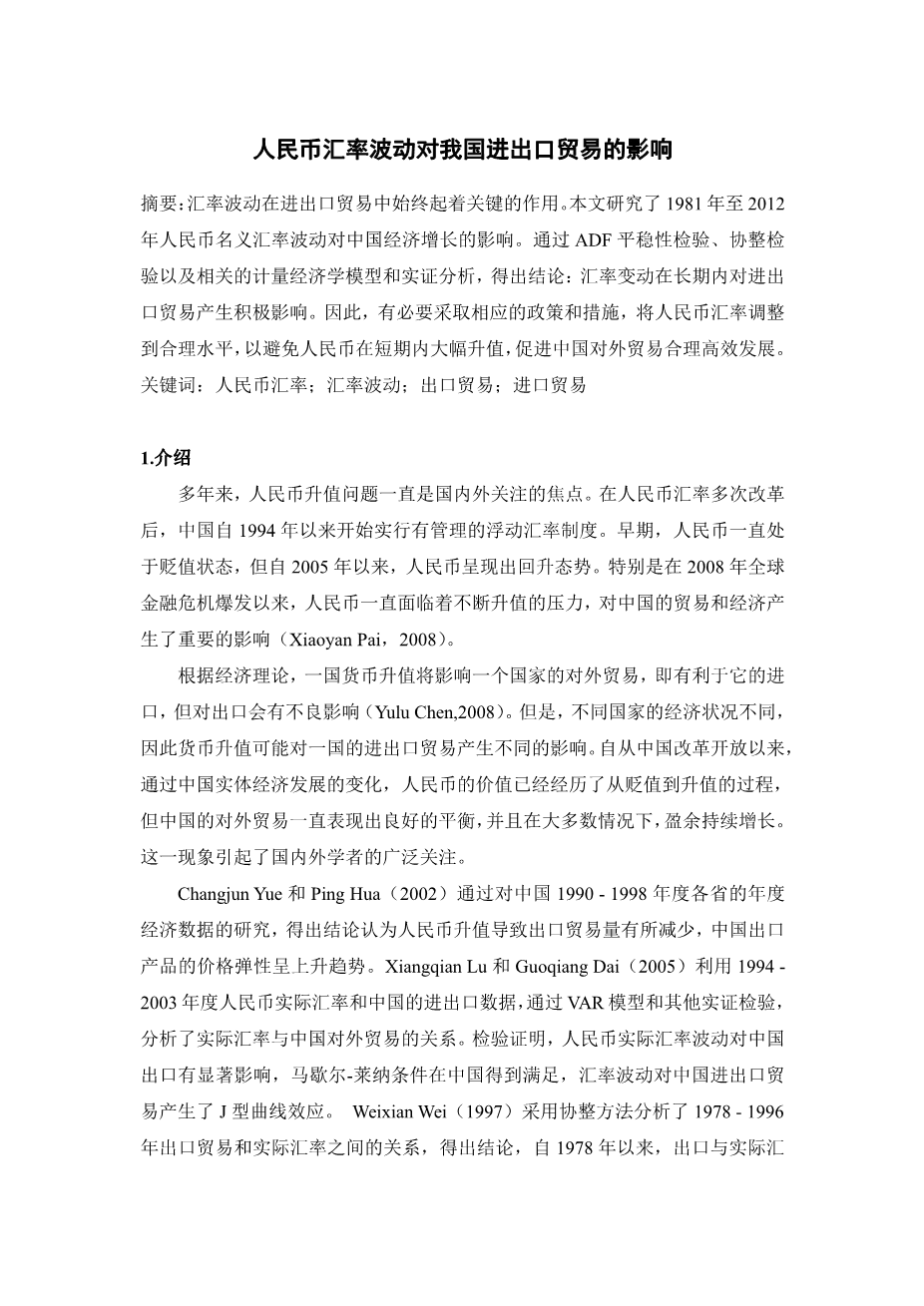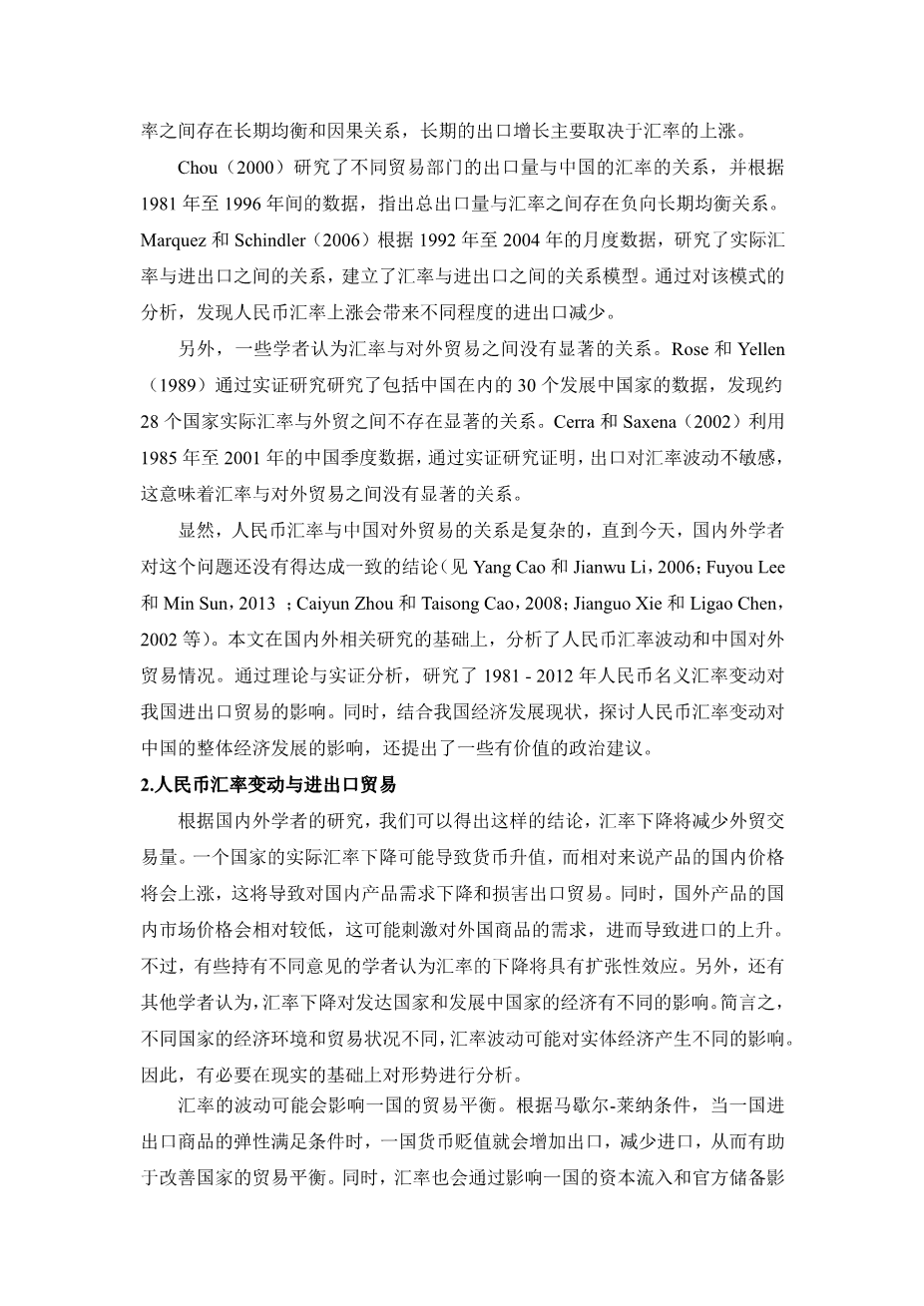The Effect of RMB Exchange Rate Volatility on Import and Export Trade in China
Wanhui Jiang
ABSTRACT:The exchange rate volatility always plays a key role in import and export trade. This paper investigates the effect of nominal RMB exchange rate volatility on economic growth in China from 1981 to 2012. Through the ADF stationary test, the co-integration test, and the associated econometric model and the empirical analysis, the paper concludes that in the long run, exchange rate change has a positive impact on import and export trade. Therefore, it is necessary to take relevant policies and measures to adjust the RMB exchange rate at a reasonable level to avoid the RMB sharp appreciation in the short-term to promote a rational and efficient development for China's foreign trade.
KEY WORDS: RMB exchange rate;Exchange rate volatility;Export trade;Import trade
1. Introduction
The issue of the Renminbi revaluation has always been a focus at home and abroad for many years. After many times reform in the RMB exchange rate, China has started a managed floating exchange rate system since 1994. In the early days, the RMB always in a depreciated situation, but since 2005 the RMB has been showing an appreciation trend. Especially after the outbreak of the global financial crisis in 2008, the RMB has been facing a constantly appreciation pressure, and this makes an important impact on China's trade and economy (Xiaoyan Pai, 2008).
According to economic theory, the appreciation of a country's currency will be beneficial to it's import, but have a bad influence on the export, which will affect a country's foreign trade (Yulu Chen, 2008). However, different country has different economic conditions, so the appreciation of currency may have different effects on a country’s import and export trade. Since Chinese economic reform and opening up, through the changes in China’s real economy development, the value of RMB has experienced a progress from devaluation to appreciation, but China's foreign trade has always been showing a favorable balance, and in most cases the surplus continues to grow. This phenomenon has aroused scholar’s widespread attention at home and abroad.
Changjun Yue and Ping Hua (2002), through studying China’s 1990-1998 annual economic data for all provinces, concluded that the RMB appreciation caused a reduction on export trade volume, besides that there is an increasing trend on price elasticity towards China’s export products. Xiangqian Lu and Guoqiang Dai (2005) using the year of 1994-2003 RMB real exchange rate and China's import and export data, and through VAR model and other empirical tests, analyzed the relationship between real exchange rates and China’s foreign trade. The tests proved that the RMB real exchange rate fluctuation had a significant influence on China’s export, and Marshall-Lerner condition was satisfied in China, and exchange rate fluctuations exists J-curve effect on China’s import and export trade. Weixian Wei (1997) using co-integration approach to analyze the year 1978-1996 export trade and real exchange rate date, concluded that since1978 there has existed long-run equilibrium and causation relations among exports and real exchange rate and long-term export growth mainly depended on the rising of exchange rate.
Chou (2000) studied the relations between the export volume of different trade department and the exchange rate in China and also the relations between it’s total export volume and the exchange rate according to the data from 1981 to 1996, and indicated that there existed a negative long-run equilibrium relation between exports and exchange rate. Marquez and Schindler (2006) studied relations between real exchange rate and foreign trade volume based on the monthly dadas from 1992 to 2004, and established the model of the relationship between exchange rate and import and export. Through analysis of the model, they found that the rise in RMB exchange rate would bring different degree reduce of imports and exports.
In addition, some scholars concluded that there are no significant relations between exchange rate and foreign trade. Rose and Yellen (1989) studied thirty developing countries’ data including China and found that about 28 countries does not exist significant relationship between real exchange rate and foreign trade through empirical research. Cerra and Saxena (2002) using the quarterly data of China from 1985 to 2001 and through empirical studies, proved that exports were not sensitive to exchange rate fluctuations, which means there is no significant relationship between exchange rate and foreign trade.
Obviously, the relations between RMB exchange rate and China's foreign trade is complex, and until today the scholars at home and abroad haven’t reached same conclusion on this problem (see Yang Cao and Jianwu Li, 2006; Fuyou Lee and Min Sun, 2013; Caiyun Zhou and Taisong Cao, 2008; Jianguo Xie and Ligao Chen, 2002, etc). On the basis of the relevant researches at home and abroad, this paper analyzes the RMB exchange rate volatility and China's foreign trade situation. Through the theoretical and empirical analysis, this paper investigates the effect of nominal RMB exchange rate changes on import and export trade in China from 1981 to 2012. At the same time, it combines China's economic development status to discuss the effect of RMB exchange rate change on China's overall economic development to put forward some valuable political suggestions, too.
2. RMB exchange rate change and import-and-export trade
According to the scholars’ research at home and abroad, we can conclude that exchange rate decline will reduce foreign trade volume. A country's real exchange rate decline may cause currency appreciation, and relatively speaking the domestic price of product will
剩余内容已隐藏,支付完成后下载完整资料


英语译文共 5 页,剩余内容已隐藏,支付完成后下载完整资料
资料编号:[484468],资料为PDF文档或Word文档,PDF文档可免费转换为Word


